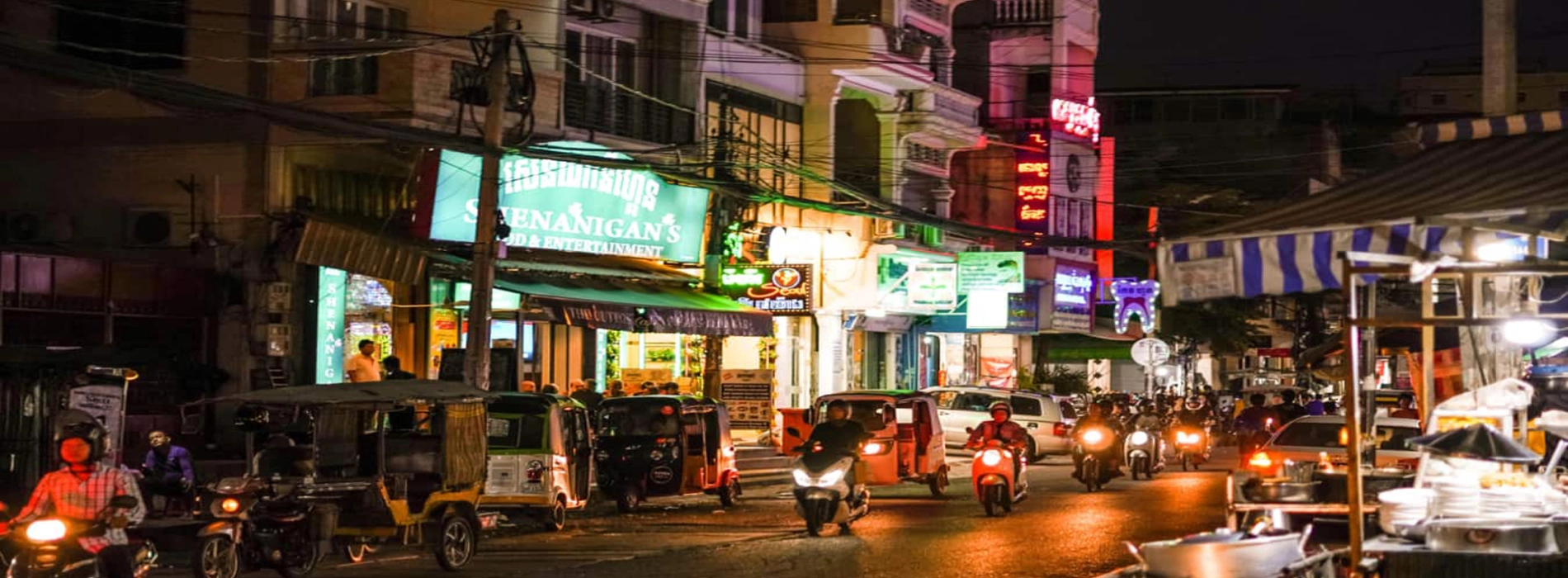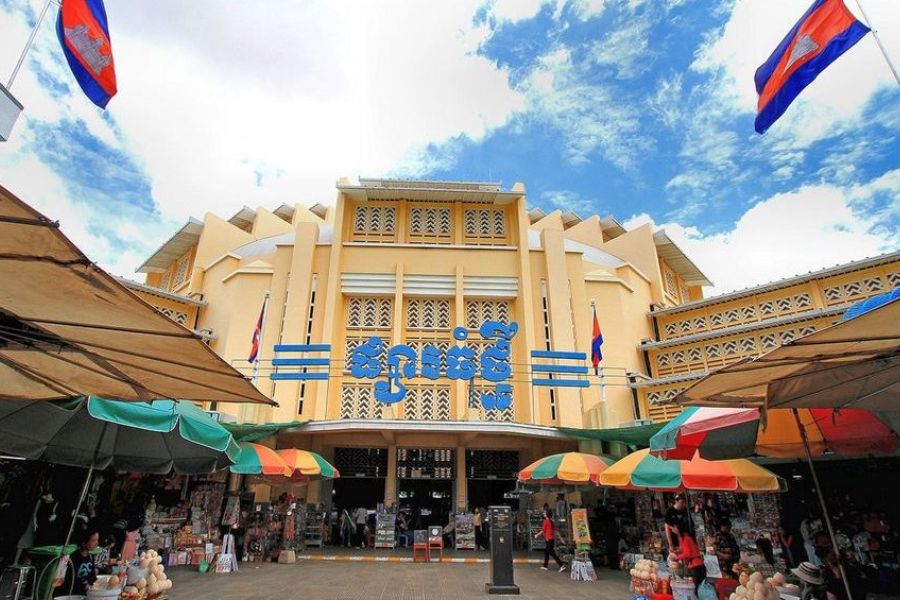Phnom Penh

Phnom Penh, also known as Nam Vang or Nam Vinh, is the largest city and capital of the Kingdom of Cambodia. Once known as the "Pearl of Asia" in the 1920s, Phnom Penh, along with Siem Reap, are two cities that attract domestic and international tourists to Cambodia. The city has many buildings with French architectural influences and many unique works of Khmer architecture. Located at the confluence of the Mekong, Tonle Sap, and Bassac rivers, Phnom Penh is regarded as the cradle of Buddhism and a vivid historical record of the Cambodian people.

Admire the Silver Pagoda in Phnom Penh - Cambodia. Source: Cambodia Tour
According to legend, in the late 14th century, when Angkor was still the Khmer capital and Phnom Penh was known as Chaktomuk, a local woman named Daun Penh ("Grandmother Penh") discovered a koki tree floating in the river. Inside the tree, she found four Buddha statues and a Vishnu figure, considered a divine sign of blessing. Daun Penh built Wat Phnom on a hill in the city’s north to enshrine these statues.
In the 15th century, King Ponhea Yat moved the Khmer capital to Phnom Penh after Angkor Thom fell to the Siamese. However, it wasn’t until 1866, during King Norodom I’s reign, that Phnom Penh became Cambodia’s permanent capital.
Under French colonial rule, the city developed with canals, roads, and a bustling port. By the 1920s, Phnom Penh earned the nickname "Pearl of Asia" for its beauty. During the Khmer Rouge era in the 1970s, the city suffered greatly under brutal oppression. Liberation came in 1979 when Vietnamese forces defeated the Khmer Rouge. Since then, Phnom Penh has been rebuilt and revitalized with international aid, emerging as a vibrant capital once more.

The architectural complex is a symbol of Cambodia. Source: Ivivu,com
Phnom Penh's climate is characterized by distinct wet and dry seasons, shaping the city's ambiance throughout the year.
The dry season, from November to April, with pleasant temperatures and clear skies, making it a ideal time for travelers to explore the city's historical and cultural gems. The months of November to February bring cooler weather, suitable for leisurely walks through bustling markets and serene temple grounds. However, as March and April arrive, the heat gradually intensifies, creating a warm and dry environment.
The wet season, on the other hand, spanning from May to October, introduces refreshing rains that rejuvenate the landscape. While showers are common during the day, they often give way to vibrant sunsets and cooler evenings. This season showcases a different side of Phnom Penh, with its lush greenery and the charm of rainy-season life. Whichever time of year one chooses to visit, Phnom Penh's allure remains undeniable, inviting travelers to immerse themselves in its dynamic atmosphere and rich cultural tapestry.

Explore the beauty of Phnom Penh - Cambodia. Source: iVivu.com
Getting to Phnom Penh, the bustling capital of Cambodia, is a seamless journey thanks to its well-connected transportation options.
For international travelers, Phnom Penh International Airport offers a multitude of flights connecting the city to various global destinations. If you prefer overland travel, an extensive network of buses, shared taxis, and minivans can efficiently transport you to Phnom Penh from within Cambodia and neighboring countries.
For a unique experience, consider traveling on the Mekong River by boat, particularly when traveling from places like Siem Reap. Once in Phnom Penh, the city's local transportation, including tuk-tuks and taxis, readily awaits to whisk you away to explore its vibrant streets, historical landmarks, and diverse cultural offerings.
You may like: Cambodia Excursions
This building was built in the spectacular Khmer architectural style. Although it is where the Cambodian king lives and works, there are still some areas open for visitors to visit. Inside the grounds is the Silver Pagoda, famous for having 5,000 silver pieces on the floor and inside is the sacred Emerald Buddha statue.

The Royal Palace. Source:Tripzone.vn
War Phnom - a renowned and sacred temple that attracts both local and international Buddhists on pilgrimage. It is also the resting place of King Boliwat and the relics of King Ponhea Yat. Notably, Wat Phnom is the origin of the name "Phnom Penh" as it is known today.

Wat Phnom. Source: Traveloka
The National Museum of Cambodia houses some of the oldest archaeological artifacts related to Khmer religion and art. Visitors can admire over half a million specimens dating from the 4th to the 13th century, showcasing the richness of the ancient Khmer Kingdom’s culture.

The National Museum of Cambodia. Source: Dat Viet Tour
Taking a boat ride along the Tonle Sap River to watch the sunset in Phnom Penh is an unforgettable experience for visitors. There are plenty of options, from spacious two-story wooden boats equipped with comfortable sofas and food and drink service, to smaller fishing boats ideal for a simple sightseeing trip. Depending on your budget, you can choose a service that suits you best. If you’re unsure about what to do in the evening in Phnom Penh, this is definitely an activity worth trying.

Watching the sunset in Phnom Penh is an unforgettable experience. Source: iViVu.com
Explore this bustling Art Deco market where you can shop for jewelry, souvenirs, and local products, and taste authentic Cambodian street food.

Phom Penh Central Market. Source: Eviva Tour
For those seeking a blend of culture, history, and adventure, Phnom Penh is not just a destination—it’s a journey into the heart of Cambodia. Don’t miss the chance to discover its charm and create unforgettable memories in this remarkable city !
You may like: Cambodia Tours 5 days
Enjoy the Phnom Penh Siem Reap Tour 5 days: Cambodian Heritage to countryside to...
Explore the vibrant culture and history of Phnom Penh with our Phnom Penh Tour 2...
The "Phnom Penh Tour 3 Days" offers an in-depth exploration of Cambodia’s vibran...